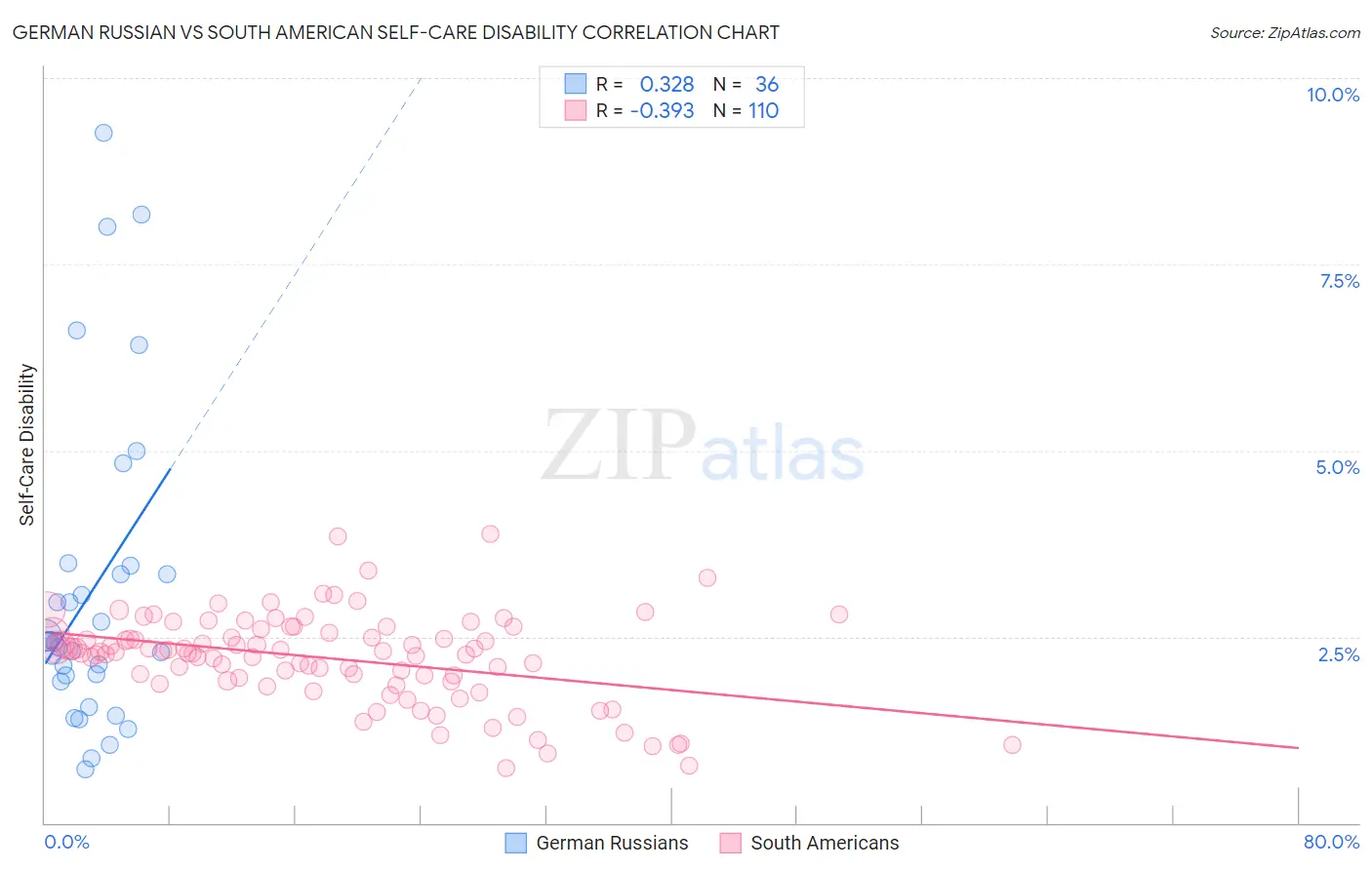German Russian vs South American Self-Care Disability
COMPARE
German Russian
South American
Self-Care Disability
Self-Care Disability Comparison
German Russians
South Americans
2.5%
SELF-CARE DISABILITY
62.7/ 100
METRIC RATING
163rd/ 347
METRIC RANK
2.4%
SELF-CARE DISABILITY
93.2/ 100
METRIC RATING
113th/ 347
METRIC RANK
German Russian vs South American Self-Care Disability Correlation Chart
The statistical analysis conducted on geographies consisting of 96,413,483 people shows a mild positive correlation between the proportion of German Russians and percentage of population with self-care disability in the United States with a correlation coefficient (R) of 0.328 and weighted average of 2.5%. Similarly, the statistical analysis conducted on geographies consisting of 493,131,874 people shows a mild negative correlation between the proportion of South Americans and percentage of population with self-care disability in the United States with a correlation coefficient (R) of -0.393 and weighted average of 2.4%, a difference of 2.6%.

Self-Care Disability Correlation Summary
| Measurement | German Russian | South American |
| Minimum | 0.71% | 0.74% |
| Maximum | 9.3% | 3.9% |
| Range | 8.5% | 3.1% |
| Mean | 3.1% | 2.2% |
| Median | 2.4% | 2.3% |
| Interquartile 25% (IQ1) | 1.9% | 1.9% |
| Interquartile 75% (IQ3) | 3.4% | 2.6% |
| Interquartile Range (IQR) | 1.5% | 0.65% |
| Standard Deviation (Sample) | 2.1% | 0.60% |
| Standard Deviation (Population) | 2.1% | 0.59% |
Similar Demographics by Self-Care Disability
Demographics Similar to German Russians by Self-Care Disability
In terms of self-care disability, the demographic groups most similar to German Russians are Somali (2.5%, a difference of 0.050%), Immigrants from Vietnam (2.5%, a difference of 0.17%), Syrian (2.5%, a difference of 0.19%), Lebanese (2.4%, a difference of 0.20%), and Canadian (2.5%, a difference of 0.20%).
| Demographics | Rating | Rank | Self-Care Disability |
| Nigerians | 70.6 /100 | #156 | Good 2.4% |
| Immigrants | Europe | 69.6 /100 | #157 | Good 2.4% |
| Immigrants | Western Europe | 68.6 /100 | #158 | Good 2.4% |
| Immigrants | Italy | 68.5 /100 | #159 | Good 2.4% |
| Finns | 67.0 /100 | #160 | Good 2.4% |
| Lebanese | 66.5 /100 | #161 | Good 2.4% |
| Somalis | 63.7 /100 | #162 | Good 2.5% |
| German Russians | 62.7 /100 | #163 | Good 2.5% |
| Immigrants | Vietnam | 59.3 /100 | #164 | Average 2.5% |
| Syrians | 59.0 /100 | #165 | Average 2.5% |
| Canadians | 58.8 /100 | #166 | Average 2.5% |
| Immigrants | Greece | 57.3 /100 | #167 | Average 2.5% |
| Ute | 57.1 /100 | #168 | Average 2.5% |
| Immigrants | Somalia | 55.9 /100 | #169 | Average 2.5% |
| Scottish | 54.3 /100 | #170 | Average 2.5% |
Demographics Similar to South Americans by Self-Care Disability
In terms of self-care disability, the demographic groups most similar to South Americans are Immigrants from North Macedonia (2.4%, a difference of 0.0%), Immigrants from Hong Kong (2.4%, a difference of 0.010%), Scandinavian (2.4%, a difference of 0.060%), Northern European (2.4%, a difference of 0.060%), and Serbian (2.4%, a difference of 0.090%).
| Demographics | Rating | Rank | Self-Care Disability |
| Immigrants | Indonesia | 94.3 /100 | #106 | Exceptional 2.4% |
| British | 94.3 /100 | #107 | Exceptional 2.4% |
| Greeks | 94.1 /100 | #108 | Exceptional 2.4% |
| Slovenes | 94.1 /100 | #109 | Exceptional 2.4% |
| Immigrants | Africa | 93.7 /100 | #110 | Exceptional 2.4% |
| Serbians | 93.6 /100 | #111 | Exceptional 2.4% |
| Scandinavians | 93.5 /100 | #112 | Exceptional 2.4% |
| South Americans | 93.2 /100 | #113 | Exceptional 2.4% |
| Immigrants | North Macedonia | 93.1 /100 | #114 | Exceptional 2.4% |
| Immigrants | Hong Kong | 93.1 /100 | #115 | Exceptional 2.4% |
| Northern Europeans | 92.9 /100 | #116 | Exceptional 2.4% |
| Taiwanese | 92.5 /100 | #117 | Exceptional 2.4% |
| Immigrants | Canada | 92.0 /100 | #118 | Exceptional 2.4% |
| Immigrants | Sierra Leone | 91.8 /100 | #119 | Exceptional 2.4% |
| Uruguayans | 91.5 /100 | #120 | Exceptional 2.4% |